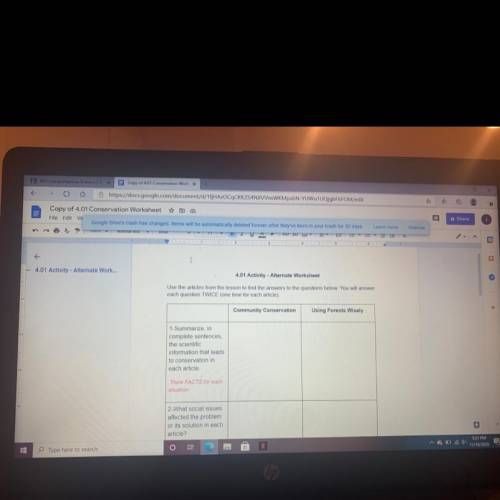
4.01 Activity - Alternate Worksheet
Use the articles from the lesson to find the answers to the questions below. You will answer
each question TWICE (one time for each article).
Community Conservation
Using Forests Wisely
1-Summarize, in
complete sentences
the scientific
information that leads
to conservation in
each article
Think FACTS for each
situation


Answers: 3


Other questions on the subject: Biology

Biology, 21.06.2019 16:30, monayemcnett11
25) a student takes four samples of a white crystalline solid and places each in a well plate. on top of each sample, she carefully places 20 drops of clear mystery liquids a, b, c and d. her results for each well are: liquid a: the solid dissolves quickly. liquid b: the solid appears unchanged. liquid c: a brownish colored liquid is produced. liquid d: fizzing occurs and the well becomes warmer. in which well does a physical change occur?
Answers: 3

Biology, 21.06.2019 21:10, RonGeffrard9597
Complete the possible outcomes for each generation in the pedigree chartaa aa aa
Answers: 1

Biology, 21.06.2019 23:00, annabellthedivp3u9ve
Use this new information to determine the parents’ genotypes (indicated by red arrows). then calculate the probabilities that the second male offspring will have each condition. drag one pink label to each pink target and one blue label to each blue target. then use the white labels to answer questions 1 and 2. labels can be used once, more than once, or not at all.
Answers: 3

Biology, 22.06.2019 01:30, eguilford4438
Scenario 5 1) take 10 red and 10 black beans and place them, mixed, on the table. record the starting phenotype # and frequencies (% of your total population) of your starting population in the table provided (generation 0). 2) act as a predator. “capture” as many organisms as you can until you have reduced the population to three organisms. put them aside. at this point, the predators die. 3) the remaining organisms each produce 2 clonal offspring. multiply your organisms accordingly and allow them to mix on the table. calculate and record the resultant phenotype # and frequencies (% of your total population) of your population in the table provided (generation 1). 4) repeat the reproduction event, allowing each of your organisms to produce 2 clonal offspring. calculate and record the resultant phenotype # and frequencies (% of your total population) of your population in the table provided (generation 2). 5) repeat the reproduction event, allowing each of your organisms to produce 2 clonal offspring. calculate and record the resultant phenotype # and frequencies (% of your total population) of your population in the table provided (generation 3).
Answers: 1
You know the right answer?
4.01 Activity - Alternate Worksheet
Use the articles from the lesson to find the answers to the que...
Questions in other subjects:


Mathematics, 14.04.2020 21:47

English, 14.04.2020 21:47




Mathematics, 14.04.2020 21:47


Social Studies, 14.04.2020 21:47



